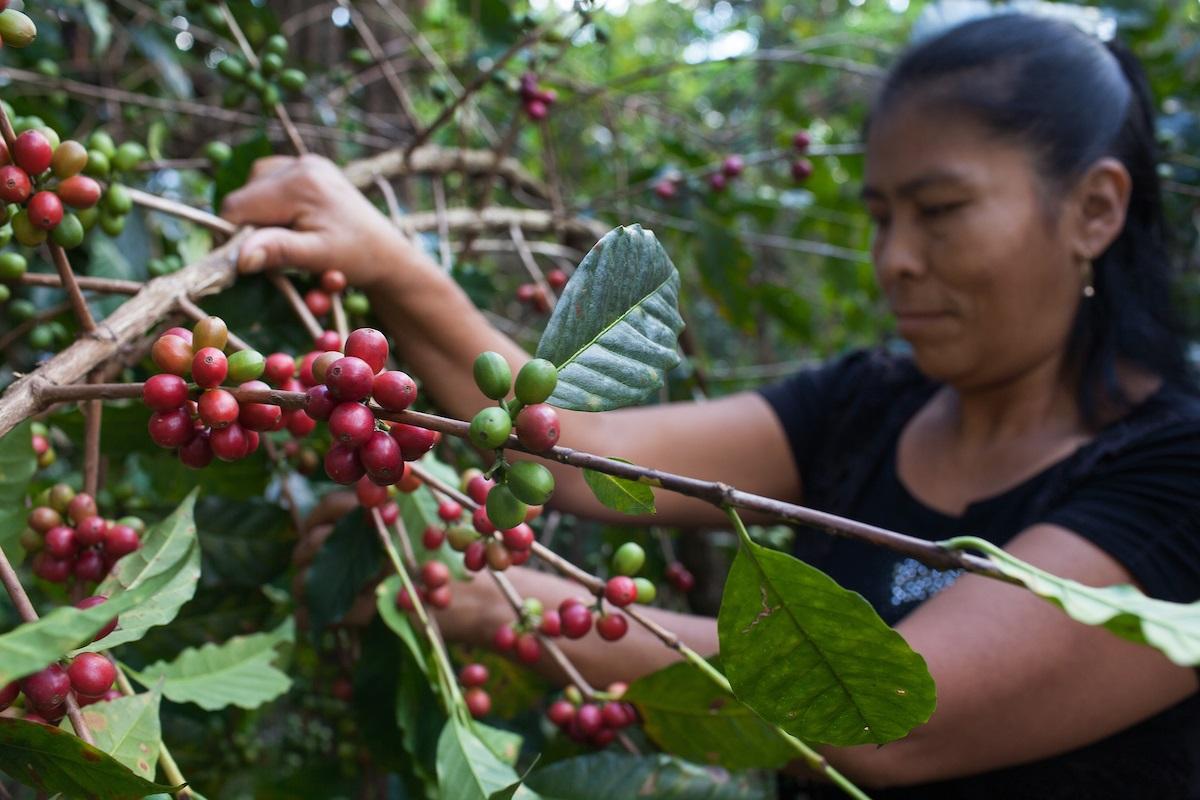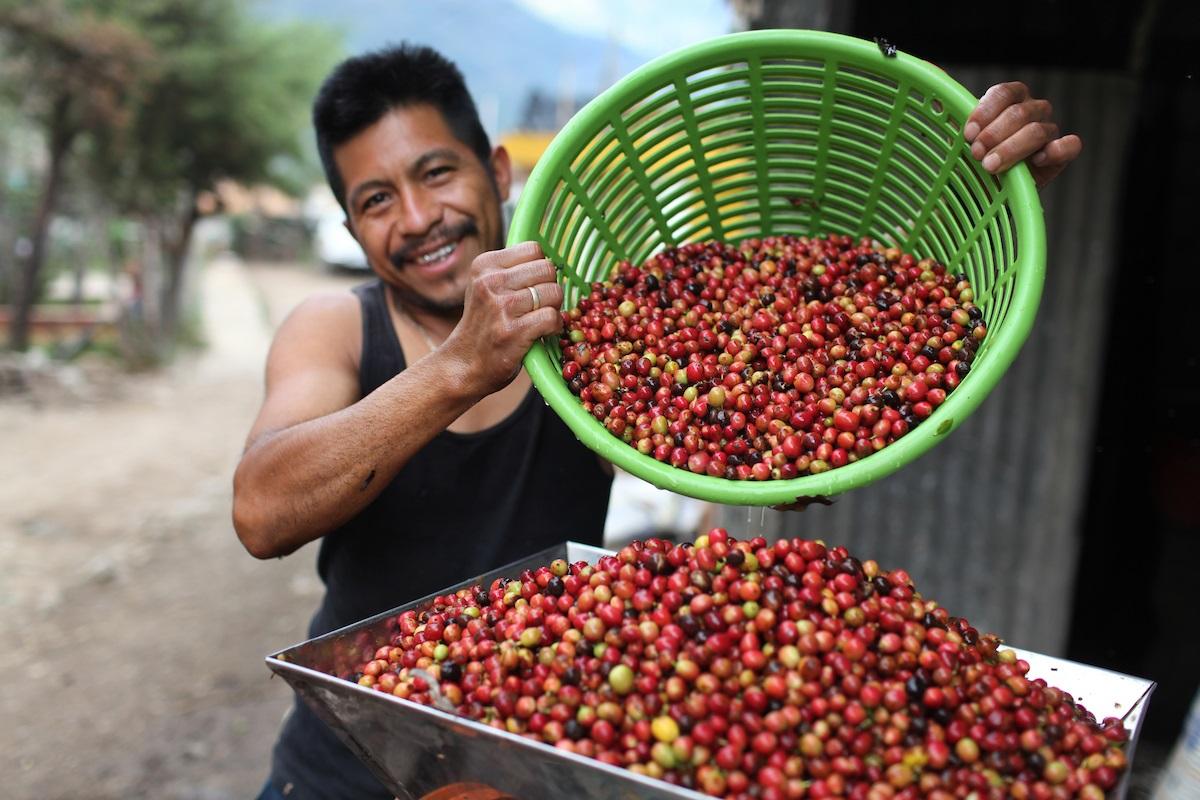The Power of Your Cup on National Coffee Day
The Power of Your Cup on National Coffee Day
Americans drink more than 400 million cups of coffee per day. If tomorrow each one of us woke up and made just one cup Fair Trade, we would drive at least an additional $2 million dollars back to coffee farmers to help them address some serious challenges. In just one day. Because of one little choice. That’s pretty amazing.
Why this matters: National Coffee Day is coming up, and, let’s face it, most of us won’t make it past noon without a good cup of joe (or three). And our addiction is growing. Purchases of coffee pods, exotic beans and other “specialty” coffee offerings have skyrocketed in recent years, pushing the value of the industry to over $48 billion in the US alone. That’s a lot of coffee!
You might think that our coffee habit would automatically bring prosperity to the people who help make it. Yet the 25 million+ people on the front line - the coffee farmers - aren’t necessarily benefitting from our high-end caffeine addiction. Despite booming business here in the US and around the globe, farmers continue to retain very little value. In fact, farmers in Latin America today are making LESS than their grandparents made decades ago. All of this is made worse by low market prices, climate change, pests and other challenges. Many are looking for a way out, because coffee farming is simply no longer a viable profession. Unless something is done, our demand could outpace supply, leaving us with a lot less amazing coffee to drink.
Most of the world’s coffee comes from Latin America, Asia and Africa, making strengthening the industry almost wholly dependent on improving the livelihoods of coffee farmers and farmworkers there. We must acknowledge and address the struggles they face if we’re to keep enjoying our favorite morning pick-me-up, on National Coffee Day and beyond.
It’s time for us all to wake up and smell the coffee.
Challenges in Your Coffee
Working Conditions
Growing and harvesting coffee is not for the faint of heart. Farmers and farmworkers must weed, spray, fertilize and prune the plants, then pick, sort and transport the beans. Many do so without the proper protective equipment, leaving them vulnerable to illness and injury. In addition, coffee grows best at high altitudes. Farm workers have to haul heavy sacks of coffee beans across steep, treacherous terrain just to get them to market.
Poverty
This is perhaps the biggest challenge that coffee farmers face. Coffee growers can receive as little as three cents of the $3.50 we pay for a cup of coffee at our local cafe. The Specialty Coffee Association reports that an average coffee farmer earns just $6800 per year. Fluctuating market prices (which once again are too low) and the cost of farming inputs whittle away at this already low figure. In Colombia, for example, high fertilizer costs push farmers’ profits down to $2,340, or $195 per month, to feed a family of four or five.
Thus begins a vicious cycle of poverty. Coffee farmers harvest and sell, making just enough to make ends meet. They face the brutal “thin months”, the period between harvest payments where many coffee farming families are forced to skip meals. The money to invest in additional land or improved farming techniques - things that might increase profits - simply isn’t there. It’s a lose-lose.
Climate Change and Disease
Environmental changes pose real threats to coffee farmers’ livelihoods. In Brazil, the world’s largest coffee exporter, production of Robusta coffee dropped 24 percent in the 2015-16 season due to drought. And the situation shows little hope of improvement. The Climate Institute estimates that by 2050 rising global temperatures and decreased rainfall will reduce areas suitable for coffee growth by approximately 50 percent. That’s HUGE.
Even where coffee can be grown, bountiful harvests are far from assured. Parasites, fungi and weeds can destroy entire harvests in the blink of an eye. In 2013, outbreaks of a pesticide-resistant fungus known as coffee leaf rust wrought havoc on coffee farms in Central America. More than 370,000 farm hands found themselves out of work as coffee farmers were forced to cut down and replant their trees. Experts fear that a recent outbreak in Honduras could spark a second epidemic - a hit that most coffee farmers simply cannot take.
Lack of Generational Succession
Given these challenges, it’s no surprise that many coffee farming families are looking for the exit. Many farmers have switched to other crops. In Ethiopia, for example, coffee farmers have begun to plant maize, which requires clearing coffee trees and damages the environment. Elsewhere, farmers are growing khat, a potentially addictive recreational drug, which fetches three to four times as much as coffee. Meanwhile their children, all-too aware of their parents’ struggles, flock to the cities in search of better opportunities.
The Future of Coffee
This is a lot to take in. We’re right there with you. It’s easy to get discouraged and feel the weight of this reality. But don’t worry - this isn’t where we tell you that your coffee-guzzling days are numbered and to brace yourself for massive caffeine withdrawals. On the contrary, you should continue drinking coffee. When done right, your favorite beverage has the power to spark positive change for millions.
Why Fair Trade Coffee?
Coffee roasters and retailers are aware of the challenges in the industry and are working with farmers to make coffee farming a viable profession. For hundreds of thousands of coffee farmers - and thousands of businesses - Fair Trade certification has emerged as one of the most effective ways to build a brighter tomorrow.
Two important mechanisms bring Fair Trade to life. The first is the Fair Trade Standard, which all coffee farmers must meet to earn certification. The Standard has over 200 criteria that work to provide farmers with safe working conditions and environmentally-friendly farming practices. It also guarantees a minimum price for coffee - $1.40 per pound - which acts as a safety net when the coffee market dips too low. Each coffee with the Fair Trade Certified seal comes from a farm with these conditions in place.
The second is the Fair Trade Community Development Fund, an additional $0.20 that farmers earn for every pound of coffee you buy. Farmers democratically vote on how to invest this money for critical community projects like education, healthcare and crop quality improvement. The best part is that we directly contribute to these funds every time we purchase Fair Trade coffee!
To date, coffee drinkers have generated more than $200 million through Fair Trade for coffee farmers to improve their lives. Here’s a small sample of these projects:
- Members of the cooperative ANSERMA in Colombia established a dental clinic that provides free or discounted care for coffee farmers and their families.
- The FEDECOCAGUA cooperative in Guatemala purchased motorized sprayers to fight coffee leaf rust with an all-natural fungicide and form an “anti-rust brigade” program. This work has provided more than 20,000 farmers with critical trainings and resources to help keep their farms afloat in the face of devastation.
- The Red Ecolsierra cooperative in Colombia established a cupping lab and hired on a professional cupper to improve the quality - and thus, value - of their coffee.
See our Global Reach Map to learn more about how coffee farmers across the world are using Fair Trade to build sustainable livelihoods.
Fair Trade and You
Every time you purchase coffee products that bear the Fair Trade Certified seal, you’re casting a vote - for a future in which coffee is plentiful and coffee farmers are empowered to lead their best possible lives.
In honor of National Coffee Day, Fair Trade USA is challenging everyone to make #JustOneCup of their daily coffee Fair Trade Certified. This simple change will generate millions of additional dollars for coffee farmers throughout the world, helping them build sustainable livelihoods and ensuring a ready supply of coffee for generations to come. Below are a few of our favorite Fair Trade options to help you get your Fair Trade fix:
- Keurig Green Mountain
- Allegro Coffee
- Barrie House
- Brooklyn Roasting Company
- Colectivo Coffee
- Death Wish Coffee
- Dillano’s Coffee Roasters
- Equator Coffee
- One Village Coffee
- Wicked Joe Coffee
Celebrate the Power of Just One Cup
Fair Trade cannot solve every issue in coffee, but it is creating meaningful change. Thanks to Fair Trade, millions of coffee farmers enjoy healthier, more sustainable livelihoods. Thousands of brands have built more transparent supply chains. Coffee lovers everywhere are asking where their coffee comes from. Slowly, we are waking up. Together, we are building a brighter future.
And it all starts with your cup.
#JustOneCup of Fair Trade coffee might seem insignificant, but when combined with the steaming mugs of millions of coffee drinkers throughout the country, it has direct, measurable impact on the people who need it the most.
We hope you’ll join us in honoring coffee farmers this National Coffee Day, one cup at a time.





